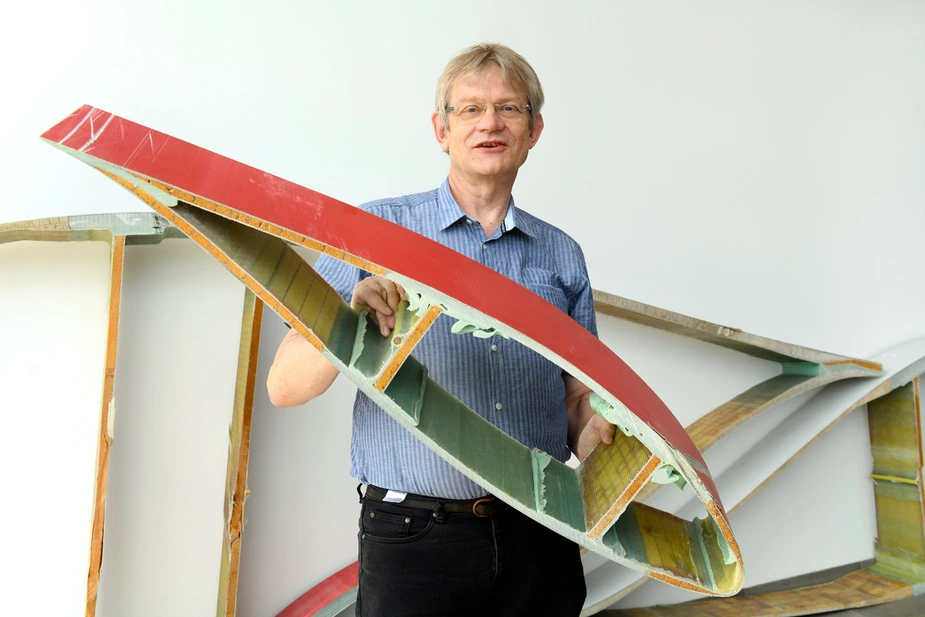Specialised in wind harvest
Adlershof's WINDnovation is thinking in terms of recycling when designing rotor blades
Since its founding in autumn 2007, WINDnovation Engineering Solutions GmbH has truly lived up to its name: The Adlershof-based company has developed over 300 different rotor blades and an array of turbines for customers all over the world. The longest of these blades, used in offshore wind wind parks, are now over 100 metres long.
Barely two years after it started up, the Berlin-based WINDnovation 2009 reported, quite literally, a huge success: It had developed 44-metre-long rotor blades for China’s first offshore wind park, which the country proudly presented at EXPO Shanghai in 2010. “Today, our offshore rotor blades have hit the 100 metre mark,” says CEO Roland Stoer. Under optimal conditions, turbines with such gigantic rotors are capable of producing 15 megawatts. In purely mathematical terms, one of them produce enough carbon-neutral electricity to power 20.000 households.
The size of the rotor blades that WINDnovation is building for wind park developers worldwide has grown, so has the company. The original team of seven has increased to 24 and moved into a new headquarters on Adlershof’s Wagner-Régeny-Strasse in July 2008. Their range of rotors and turbines is also growing. The team has developed over 300 types of rotor blades, starting at a length of ten metres. “Most often, we custom-make the design to match the facilities and the local wind conditions,” says Stoer. These can include, for example, thin mountain air. Rotor blades that yield good harvests in flat areas have too little surface area. Blade designs are developed using simulations. Alternatively, customers can chose from a range of off-the-shelf solutions. “We support them during the selection process and help with connecting the blades with the turbines in the best-possible way,” he explains.
Developing wind turbines is another pillar of the company. They mostly deal in small-scale, tailored systems for medium-sized companies. “We don’t try to compete with our blade customers,” says Stoer. Apart from three world market leaders, who develop and manufacture their blades themselves, all turbine suppliers rely on WINDnovation. Since most of them are machine engineers, whose core skills lie in mechanics and electronics, they are happy to leave the design of the ever larger, more specifically crafted, and fibre-reinforced plastic blades to the specialists from Adlershof.
Today, the team is working tirelessly for their target groups in China, India, Brasil and other countries—and has raised the bar for copy cats. World-record rotor blades and innovations were what defined them during the first ten years. When it comes to sustainability, there’s still a lot do. More and more turbines are reaching the end of their service life; until now, however, there was a lack of options how to reuse the complex, multi-material sandwiches inside their rotor blades. The result is several million tons of hazardous waste worldwide. WINDnovation is bent on contributing to a change. Stoer sees opportunities in more recycling-friendly constructions, reusable plastics, and use of natural fibres. However, these measures will only help to change future facilities. In view of the accumulating old-age rotor blades, the expert points to a little-noticed thermal decomposition procedure. “This can be used to separate the energy-rich resin from the fibres and use it as a fuel gas, which is relatively clean process. The freed-up fibres can be reused for reinforcing other components,” he explains. Such processes should become widespread quickly. Because one thing is certain: The global expansion of wind energy will pick up speed in the years to come. With more and more countries, including China, pledging to become carbon-neutral by 2050, there is no way around wind power. The more efficient and sustainable, the better. The WINDnovation team will make sure it happens.
By Peter Trechow for Adlershof Journal
